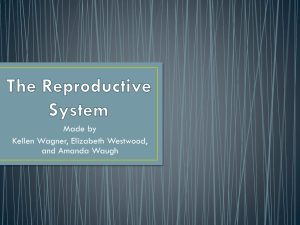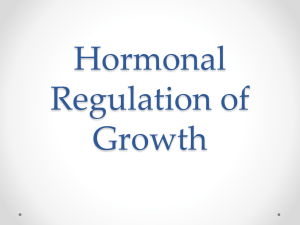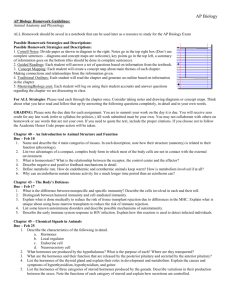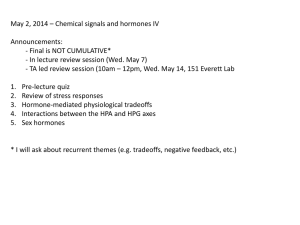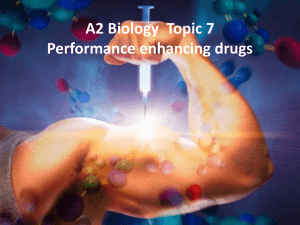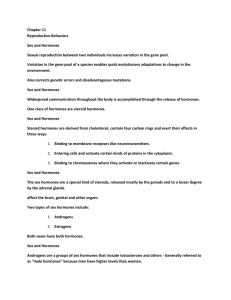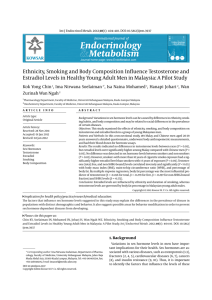Kalat Ch.11 Notes
advertisement
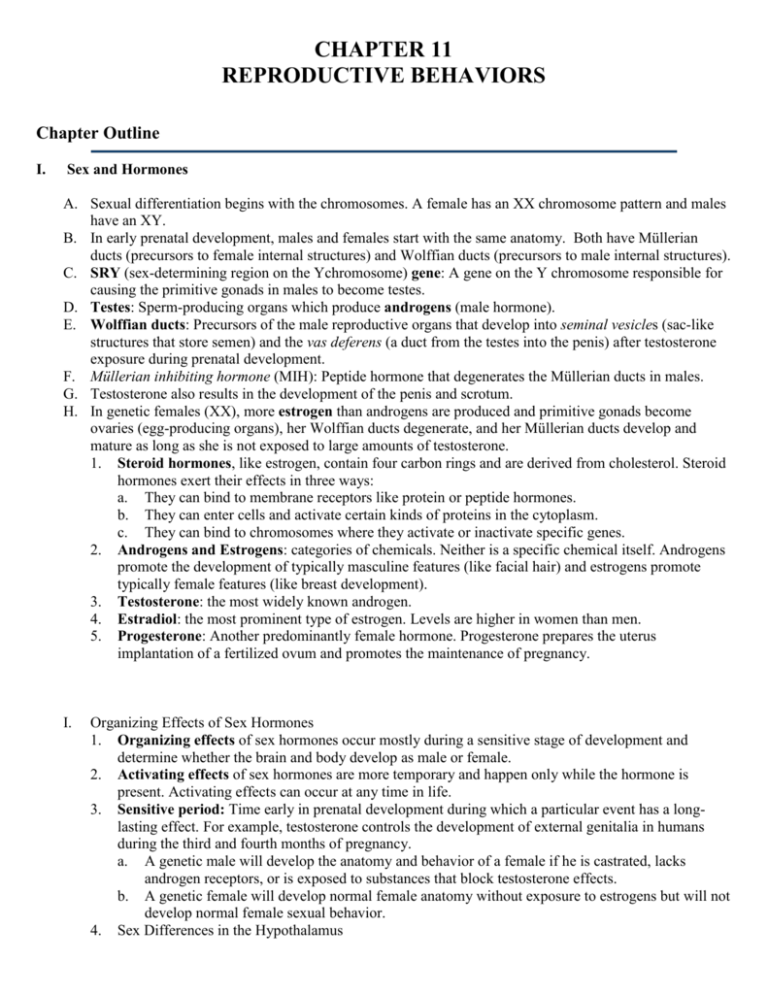
CHAPTER 11 REPRODUCTIVE BEHAVIORS Chapter Outline I. Sex and Hormones A. Sexual differentiation begins with the chromosomes. A female has an XX chromosome pattern and males have an XY. B. In early prenatal development, males and females start with the same anatomy. Both have Müllerian ducts (precursors to female internal structures) and Wolffian ducts (precursors to male internal structures). C. SRY (sex-determining region on the Ychromosome) gene: A gene on the Y chromosome responsible for causing the primitive gonads in males to become testes. D. Testes: Sperm-producing organs which produce androgens (male hormone). E. Wolffian ducts: Precursors of the male reproductive organs that develop into seminal vesicles (sac-like structures that store semen) and the vas deferens (a duct from the testes into the penis) after testosterone exposure during prenatal development. F. Müllerian inhibiting hormone (MIH): Peptide hormone that degenerates the Müllerian ducts in males. G. Testosterone also results in the development of the penis and scrotum. H. In genetic females (XX), more estrogen than androgens are produced and primitive gonads become ovaries (egg-producing organs), her Wolffian ducts degenerate, and her Müllerian ducts develop and mature as long as she is not exposed to large amounts of testosterone. 1. Steroid hormones, like estrogen, contain four carbon rings and are derived from cholesterol. Steroid hormones exert their effects in three ways: a. They can bind to membrane receptors like protein or peptide hormones. b. They can enter cells and activate certain kinds of proteins in the cytoplasm. c. They can bind to chromosomes where they activate or inactivate specific genes. 2. Androgens and Estrogens: categories of chemicals. Neither is a specific chemical itself. Androgens promote the development of typically masculine features (like facial hair) and estrogens promote typically female features (like breast development). 3. Testosterone: the most widely known androgen. 4. Estradiol: the most prominent type of estrogen. Levels are higher in women than men. 5. Progesterone: Another predominantly female hormone. Progesterone prepares the uterus implantation of a fertilized ovum and promotes the maintenance of pregnancy. I. Organizing Effects of Sex Hormones 1. Organizing effects of sex hormones occur mostly during a sensitive stage of development and determine whether the brain and body develop as male or female. 2. Activating effects of sex hormones are more temporary and happen only while the hormone is present. Activating effects can occur at any time in life. 3. Sensitive period: Time early in prenatal development during which a particular event has a longlasting effect. For example, testosterone controls the development of external genitalia in humans during the third and fourth months of pregnancy. a. A genetic male will develop the anatomy and behavior of a female if he is castrated, lacks androgen receptors, or is exposed to substances that block testosterone effects. b. A genetic female will develop normal female anatomy without exposure to estrogens but will not develop normal female sexual behavior. 4. Sex Differences in the Hypothalamus a. J. The sexually dimorphic nucleus: Part of the medial preoptic hypothalamus that is larger in the male than in the female. This area is linked to male sexual behavior. b. The female hypothalamus differs from the male hypothalamus in that the former can generate a cyclic pattern of hormone release, whereas the latter cannot. c. In rodents, testosterone is converted into estradiol inside neurons by the enzyme aromatase to masculinize the hypothalamus. d. Alpha-fetoprotein: A protein that binds with estrogen and keeps it from entering cells during the early sensitive period (this process prevents females from becoming masculinized by their own estrogen). 5. Sex Difference in Childhood Behavior a. Do prenatal hormones influence childhood behavior? Studies show that young children (3-8 months old) show a preference towards different kinds of toys. Girls look at dolls more often and boys look at dolls and trucks equally. b. Studies with monkeys show that male monkeys play with trucks and balls more than female monkeys, who played more with dolls. c. Other studies show that prenatal injections of testosterone into female monkey fetuses led to increased masculine-type play after they were born. d. There are also childrearing differences between boys and girls that contribute to behavioral differences between genders. Activating Effects of Sex Hormones 1. Rodents a. Sex hormones activate sexual behavior partly by enhancing sensations. Testosterone is essential for male sexual arousal. Estrogens increase sensitivity of the pudendal nerve which transmits tactile stimulation from the pubic area to the brain. Sex hormones also facilitate sexual behavior by binding to receptors in the brain and increasing neuronal activity. b. The medial preoptic area (MPOA), ventromedial nucleus, and anterior hypothalamus are principal areas affected by sex hormones. Part of the anterior hypothalamus is known as the sexually dimorphic nucleus (SDN) because it is larger in males than females; however, the exact importance of this area is unclear. c. Sex hormones prime the MPOA and other areas to release dopamine. d. At low concentrations, dopamine stimulates D1 and D5 receptors, which facilitate penile erection in males and sexually receptive postures in female rats. Higher concentrations of dopamine stimulate D2 receptors which lead to orgasm. e. Research has found a major difference between male and female rats in their sexual motivation: male rats showed a clear preference to return to a cage where they had previously had sex with a female rat. However, female rats find sex reinforcing only if they get to decide when it occurs. 2. Humans a. Testosterone Higher levels of testosterone are associated with seeking more sexual partners, even after they marry or establish a long-term relationship. Decreases in testosterone levels generally decrease sexual activity. Testosterone levels do not change after marriage. Instead, men with lower testosterone levels are more likely to marry than those with high testosterone levels. Single women have higher testosterone levels that women with a long-term partner (either homosexual or heterosexual). Impotence: Inability to have an erection (this is usually not caused by low testosterone levels in the body). Impotence can be treated by increasing blood circulation in the penis and hypothalamus. Decreasing testosterone activity is a method used to treat sex offenders. b. Estadiol and Related Hormones Menstrual cycle: A periodic variation in hormones and fertility over the course of about 28 days. c. At the end of the menstrual period, the anterior pituitary releases follicle-stimulating hormone (FSH) that promotes the growth of a follicle in the ovary. Toward the middle of the menstrual cycle, the follicle produces increasing amounts of estradiol (a type of estrogen); this leads to an increased release of FSH and luteinizing hormone (LH) from the anterior pituitary. FSH and LH cause the follicle to release an ovum. Progesterone is released from the remnant of the follicle and prepares the uterus for implantation of a fertilized ovum. At the end of the menstrual cycle, the levels of LH, FSH, estradiol, and progesterone all decline. If the ovum is fertilized, the levels of estradiol and progesterone increase throughout pregnancy. Birth-control pills, such as the combination pill (which contains both estrogen and progesterone) prevents the surge of FSH and LH that would release an ovum. The estrogenprogesterone combination also makes it harder for a sperm to reach the egg and for an egg to be implanted in the uterus. Periovulatory period: Midway point of the menstrual cycle when sexual interest increases, possibly due to high estrogen levels. The hormones associated with fertility move women’s mate preferences toward men who look and act more masculine. Oxytocin Oxytocin is important for reproductive behavior because it stimulates contractions of the uterus during delivery of a baby and it stimulates the mammary gland to release milk. Sexual pleasure also releases oxytocin, especially at orgasm, which is typically experienced as a state of relaxation and decreased anxiety. It is also responsible for the formation of pair bond, like the bond between two mating partners or the bond between mother and infant. It facilitates other social behaviors, like recognizing familiar faces and recognizing blurry words that relate to social relationships (like love or kissing) on a screen. K. Parental Behavior 1. An increase in estradiol, oxytocin, and prolactin by the day of delivery is important for the onset of maternal behaviors in most birds and mammals (with the possible exception of humans). 2. Hormones act by increasing activity in the medial preoptic area and anterior hypothalamus. 3. Vasopressin also appears to be important for parental behavior especially for males. Male prairie voles with high levels of vasopressin establish long-term pair bonds with females and help rear their young. 4. Later stages of maternal behavior in rodents are not dependent on hormones. Rat mothers have shown tendencies to adopt and nurture baby rats after a few days of being in their presence (after she has become familiar with their smell, as the babies’ pheromone elicit an aggressive reaction). 5. In humans, hormonal changes are not necessary for parental behavior. Hence, the successful adoption of children.

